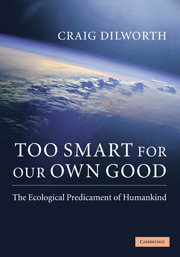Book contents
- Frontmatter
- Contents
- List of figures and tables
- Preface
- Introduction
- 1 Scientific ground rules
- 2 The new views in anthropology, archaeology and economics
- 3 Theoretical background to the vicious circle principle
- 4 The vicious circle principle of the development of humankind
- 5 The development of humankind
- 6 The vicious circle today
- 7 … and too dumb to change
- Conclusion
- Glossary
- Notes
- References
- Index
5 - The development of humankind
Published online by Cambridge University Press: 25 January 2011
- Frontmatter
- Contents
- List of figures and tables
- Preface
- Introduction
- 1 Scientific ground rules
- 2 The new views in anthropology, archaeology and economics
- 3 Theoretical background to the vicious circle principle
- 4 The vicious circle principle of the development of humankind
- 5 The development of humankind
- 6 The vicious circle today
- 7 … and too dumb to change
- Conclusion
- Glossary
- Notes
- References
- Index
Summary
The application of the vicious circle principle to humankind's development is intended to explain that development. To do this it should indicate its cause(s). On the VCP, the one key cause (which is also an effect) distinguishing our development from what is the case with other animals is technological innovation. Other causes/effects necessary to the operation of the principle include population growth, resource depletion and so on. Together, all of these phenomena constitute the vicious circle, the turning of which itself constitutes the development of humankind.
In order to demonstrate the applicability and thus explanatory power of the VCP, in this chapter each of the major episodes of humankind's development will be described in some detail and then analysed in terms of the principle.
Apes and protohominids 7 millionbp
After the demise of the dinosaurs 65 million years ago, mammals gradually became the most dominant life form on earth, the most intelligent of the mammals being the primates, and the most intelligent of the primates, the apes. Due to the separation of the South American, Eurasian and African continents beginning some 150 million years ago, the primates in these three areas afterwards evolved separately. In Africa, apes diverged from monkeys about 23 million years ago, with humans descending from these African apes, our branch splitting off from the ancestors of chimpanzees perhaps as recently as five and a half million years ago, and no earlier than eight million years ago.
- Type
- Chapter
- Information
- Too Smart for our Own GoodThe Ecological Predicament of Humankind, pp. 168 - 355Publisher: Cambridge University PressPrint publication year: 2009

